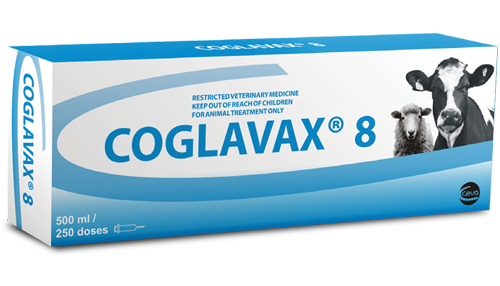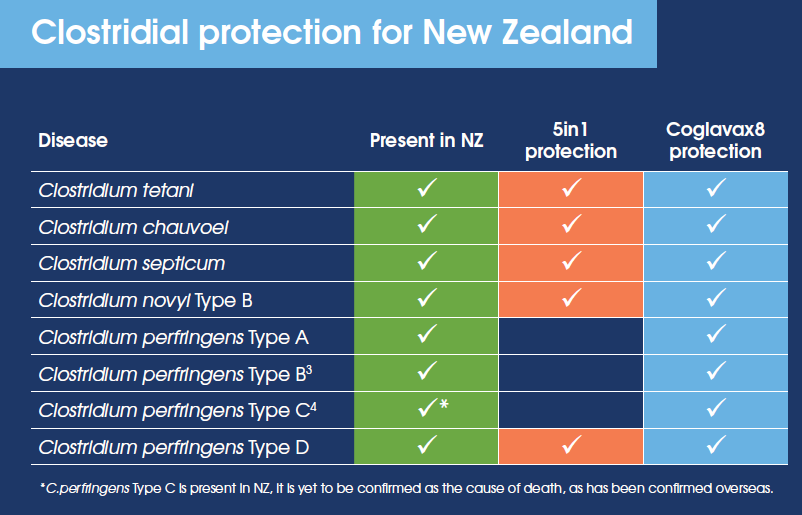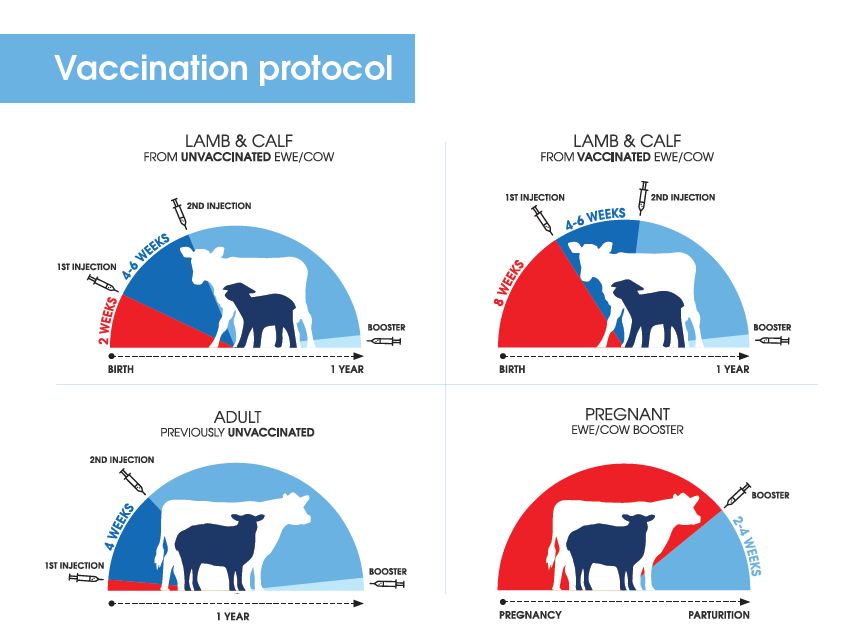Clostridial disease is complex
Protecting your stock doesn’t need to be

IT’S TIME TO STEP UP TO COGLAVAX8 8IN1 PROTECTION

Coglavax8 8in1 Clostridial Vaccine
New Zealand’s only 8in1 clostridial vaccine
Protecting against 8 clostridial diseases that are present in New Zealand.
Coglavax8 is produced by Ceva Animal Health, a global top 10 animal health company with significant expertise in the field of vaccines across a variety of animals.
Step up to 8in1 protection
Coglavax8 protects against 8 clostridial diseases including the 5 found in 5in1. If you are seeing any clostridial deaths using 5in1 then it might be time to upgrade to Coglavax8.
Its been 40+ years since 5in1 was introduced, in that time farm management and feed types have changed, so has the risk of clostridial disease.
Get more protection, reduce the risk, upgrade to Coglavax8 8in1.
Coglavax8 is produced by Ceva Animal Health, a global top 10 animal health company with significant expertise in the field of vaccines across a variety of animals.
Making up for stock losses is hard work, more protection is easy.
Clostridial Disease in NZ – Disease Breakdown
Clostridium perfringens Types A, B, C, D
- Clostridium perfringens produces enteric diseases, generically called enterotoxaemias.
- This microorganism can be a normal inhabitant of the intestine but when the intestinal environment is altered by sudden changes in diet or other factors, C.perfringens proliferates and produces potent toxins that act locally or are absorbed into the general circulation with usually devastating effects on the host.
- C.perfringens (Types A, B, C, and D) is probably the most widespread pathogenic bacteria in the world.1,2
- C.perfringens is difficult to diagnose in NZ due to speed of death and decomposition, many similar visual presentations and fast toxin degradation after death.
Clostridium perfringens Type A (Enterotoxaemia, sudden death)
- Found in soil and gut. Cases often related to feed transition and of high power grass, crop.
- Indentified in NZ since 1990.3
- Sudden, often mistaken as other diseases due to similar visual signs such as pulpy kidney.
Clostridium perfringens Type B (Enterotoxaemia, Lamb dysentery)
- Cause of death in neonatal lambs, often with no clinical signs before death.
- Positive identification in causing lamb death in NZ in 2020.4
- Cause of calf enterotoxaemia.
Clostridium perfringens Type C (Enterotoxaemia, Struck)
- Present in NZ, yet to be identified in the direct cause of death as it has been seen overseas.5
- Calf enterotoxaemia and struck in adult sheep.
Clostridium perfringens Type D (Enterotoxaemia, Pulpy kidney)
- Seen in animals after feed changes causing overgrowth of C.perfringens to release toxins.
- Excitement, incoordination, and convulsions can be seen prior to a rapid death.
- Possible diagnosis to be mistaken for in cases of C.perfringens Type A.2
Clostridium tetani (Tetanus, Lockjaw)
- Found in soil and enters via wound, commonly seen in lambs after docking.
- Time of death averages 10-14 days after exposure.
Clostridium chauvoei (Black leg)
- Found in soil, injested and can live in gut. Onset is sudden and death follows rapidly.
- Affected muscle will turn dark red to black, hence name. Wounds or bruising may trigger disease but not always involved.
Clostridium septicum (Malignant oedema, Braxy)
- Found in soil and gut. Animals can be infected via small wounds.
- Signs 6-48hrs after infection include swelling (edema). Visually can be similar to Blackleg as muscle also darkens. Death follows 24-48hrs.
Clostridium novyi Type B (Black disease, Necrotic Hepatitis)
- Soilborne and can live in gastrointestinal systems.
- Associated with liver disease. Animals often found dead with no other clinical signs.
Clostridial Disease in NZ – Understanding Risks
Protection levels
Clostridial disease is specific and so are vaccines, your stock will only be protected against what is in your vaccine so take time to compare. Choose a vaccine that covers all your main risks. A take home message is, making up for any stock loss is hard work, giving them more protection is easy.
Antibody levels
Clostridial vaccines require a sensitizer shot and a booster shot to generate a satisfactory immune response before moving to annual boosters. Animals that only receive partial protocols are unlikely to maintain antibody levels and will be at higher risk of disease and losses.
Speed of clostridial disease death
All the main clostridial diseases present in New Zealand can be fatal to unvaccinated animals. Clostridial disease death can occur within 6 to 36hrs, especially fast with sudden death, and then followed by rapid decomposition. Often sporadic, difficult to diagnose, and seldom treatable, your best protection is vaccination.
Passive and active immunity in lambs
Prelamb vaccination is to protect ewes and deliver Passive Immunity on to lambs.
It relies on lambs receiving enough colostrum, which can be impacted by the number of lambs suckling, dominance of siblings, and the condition of the ewe to name a few things. Farmers depend on this protection for younger lambs however there is always some uncertainty about the level of protection across all lambs. Consider direct vaccination of lambs that don’t make the first draft so that they have Active Immunity.
Enterotoxaemia
Enteric diseases that can result in rapid stock death.
Commonly related to a sudden change in diet during feed transition or after lack of feed.
Incidence increasing as we use more higher power feeds and crops.
Deaths can appear sporadic, adding up over time, often affecting your best animals.
Fast and fatal, difficult to reverse even if caught early.
Common situations that can lead to entertoxaemia:
- Anytime off feed that will cause animals to empty out and become hungry
– Mustering and time into yards for drenching, dipping, vaccination
– Time in woolshed for dagging, crutching, shearing
– Stock transport, especially after sales or longer distance
- Break feeding
– Creates a situation of rapid change from low to high feed availability
- Any sudden high food availability on empty stomach or low feed
- Stock movement from low level or poor quality to high power feed or lush pasture
If you are seeing deaths associated with any of the above situations, then moving to an 8in1 vaccine could deliver more profit to your farm. Speak to your vet or contact us directly.
Coglavax8 helping NZ Farmers
Lorne Peak Station, Southland
Waipuna Farms, Whanganui
Brownrigg Agriculture, Hawkes Bay

Vaccine Protocol
Direction for Use:
- Shake well before use.
- Inject subcutaneously (under the skin) in the anterior half of the neck.
- Observe the usual aseptic precautions in the administration of this vaccine.
Dose
| Sheep (all ages) | 2mL |
| Calves < 100kg | 2mL |
| Calves and adult cattle | 4mL |
Notes on Immunity
Active immunity – vaccination stimulates the immune system to produce antibodies which are detectable, within 10-14 days. To stimulate adequate protection in previously unvaccinated animals, a second dose should be given 4-6 weeks after the first. The first or sensitising dose primes the immune system and results in a relatively low, shorter-duration immunity. The second or booster dose results in a higher level of protection lasting for a year. After the second dose is given, it is then necessary to give only one dose, 2-4 weeks prior to lambing as an annual booster to provide strong, long-lasting immunity.
Passive immunity – the transfer of protective antibodies from the ewe to the lamb via the colostrum. When the ewe is vaccinated 2-4 weeks prior to lambing the high level of immunity developed allows the passive transfer of antibodies during suckling. This protection lasts 3-4 months.

Contact Us
We will respond by email
Or put in your phone number and we will give you a call back
